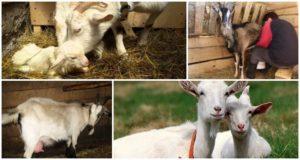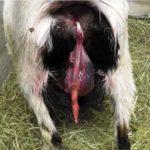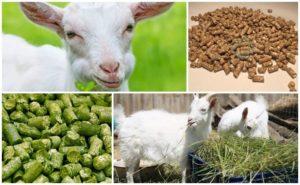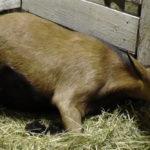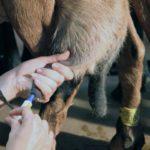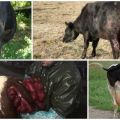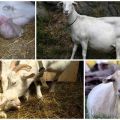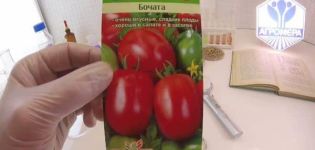Causes of discharge in a goat after lambing and methods of treatment, prevention
Bloody discharge in a goat often occurs immediately after lambing, bleeding is especially intense in a goat prone to multiple births. The attentive attitude of the owner and the veterinarian will help to avoid serious complications for the pet's health. In the postpartum period, a properly composed diet, care and hygiene procedures are important for the animal.
Causes of discharge in a goat after lambing
Slight discharge from a goat after childbirth is a natural phenomenon. Within 30 minutes, the genitals of the animal return to normal. However, if bleeding continues, watch out.
Postpartum complications can be caused by:
- Laxity of the muscles of the uterus. Experts call this phenomenon subinvolution. The organ contracts slightly, so the bleeding does not stop. Trouble often happens with pets in cramped conditions. A sedentary lifestyle has a detrimental effect on the muscle tone of the goat. Another reason for the subinvolution of the animal's uterus is multiple pregnancy. Some record holders are able to bring 3-4 kids at a time. After such a test, it is not easy for the uterus to return to its original form. On the eve of childbirth, experienced owners treat their pet with supplements high in vitamin A.
- Mechanical damage to the external and internal genital organs. In the normal course of childbirth, a kid is born in an optimal physiological position, when the forelimbs of the cub are directed forward, and the head lies on extended legs. If at birth the baby changes its position, then the goat, in most cases, receives painful injuries in the uterus and vagina. Rough attempts to tear off the placenta or suspension of a load from the placenta lead to mechanical damage. The afterbirth is closely fused with the mucous membrane of the uterus, therefore, as a result of barbaric actions, along with the placenta, the uterus of the animal can come off.
- Infection of the birth canal resulting from improper care of the goat.
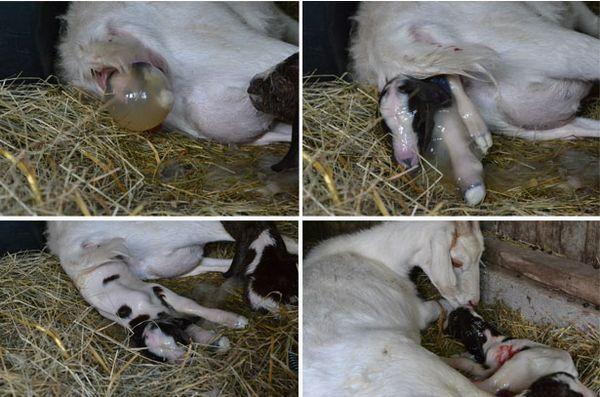
Physiological
With a successful outcome of childbirth, small bloody discharge is observed within half an hour. First, a reddish-brown ichor appears, then its shade changes, acquiring a light pink color. If after 30-40 minutes the bleeding stops, then the lamb passed without problems.
First, a reddish-brown ichor appears, then its shade changes, acquiring a light pink color.As the wounds heal, the ichor acquires a yellow tint. The discharge does not have a pungent, unpleasant odor. The pet's condition remains normal, so no doctor's help is required.
Pathological
Inflammatory processes in the internal and external genital organs of a woman in labor are of great danger to animals. The problems that have arisen are signaled by purulent discharge from the goat's genital slit. If you miss the time and do not see a doctor, the pet risks dying in two weeks.
An attentive owner should be alerted:
- Increased body temperature of the animal. When measuring the temperature in a healthy pet, the thermometer shows 38.5-40 degrees.
- Purulent discharge is a formidable sign of acute inflammation of the internal genital organs of the goat. An admixture of pus gives the ichor a brown tint and a sharp, unpleasant odor. In some cases, the discharge is completely pus. They are distinguished by their white color, thick consistency and bad odor. As a result of inflammation in the uterus and vagina of the animal, a purulent-necrotic process develops. The cause of the complication lies in the spread of the infection to the vagina and uterus. An incompletely released afterbirth leads to serious consequences. Its remains continue to be in the animal's body and provoke endometritis. Infection is often due to poor goat care during the postpartum period. If treatment is not started on time, the animal will die from sepsis.
- The appearance of bloody and putrefactive discharge. They arise when the natural mechanism for cleaning the uterus of an animal is disturbed. In this case, you need to urgently contact a veterinarian, otherwise the owners risk losing their pet. Sepsis or uterine necrosis is a sure death for an animal.
- The appearance of bright scarlet blood. It can arise directly during childbirth or in the very first hours after lambing. If, when a baby appears, scarlet blood flows along with mucous secretions, it means that things are bad. Complication occurs due to damage to the internal organs of the animal during lambing. The reason for the disruption of the natural course of events can be the wrong position of the fetus or the weak muscles of the uterus.
The appearance of scarlet blood from a goat's loop is a good reason for calling a specialist. Bleeding often causes the death of a pet.
First aid for bleeding
If the birth went according to a bad scenario and spotting appeared under the goat's tail, it is time to take emergency measures. The best way to avoid a sad outcome is urgent veterinary assistance. As a rule, experts use drugs "Vikasol" or "Dicinon". These drugs are designed to stop bleeding. With the help of drugs, the blood is cleansed, its coagulability increases. Apply the medicine 2 times a day, in a dosage of 2 ml. The course of treatment is designed for 3 days.

Treatment rules
If suspicious discharge appears under the tail of a pet, you should immediately consult a specialist and start treatment. If the situation of the animal deteriorates catastrophically, and medical assistance is not available, you should resort to the necessary drugs.
- The drug "Oxytocin" will help to strengthen the contractions of the uterus. The medicine is administered within 3 days. To achieve a positive result, it is enough to inject one ampoule twice a day.
- To strengthen the body of the pet use the "Catosal". It is administered intramuscularly for 5 days. You need to inject once a day, the dose of the drug is 8 ml.
- The antibiotic "Cefazolin" will help to prevent the development of a purulent process. It is administered 2 times a day for 1 g. Each dose is diluted with 4 ml of novocaine. The course of treatment lasts a week.
The injection is done only after the injection site has been treated with an alcohol solution.The drug is injected exclusively into the muscle of the hind limb, otherwise the bone of the affected animal can be hurt, and the matter will end in inflammation.
Prevention
Weakened by pregnancy and childbirth, the goat is provided with lightweight nutrition. Most of the diet should consist of dry leaves and well-dried hay. After giving birth, the animal needs additional support.
As a general tonic, the goat is treated with a sugar solution. For this, 100 g of granulated sugar is diluted with 500 ml of warm water.
An hour later, the pet must be drunk with a decoction made from onion husks. The drink enhances the process of contraction of the goat's uterus. To prepare the potion, you will need: a handful of dry onion husks, 1 teaspoon of salt and 2 tablespoons of sugar. The ingredients are poured over 500 ml of boiling water and simmered over low heat for 20 minutes. Then the broth is removed from heat and left to cool completely. The finished drink is given to the animal along with the onion husk.
For the fastest separation of the placenta, the animal is given a gentle massage. With light movements, the woman in labor is stroked in the abdomen. In this case, the hand is directed from the front legs of the pet to the hind limbs. The duration of the procedure is 2 minutes.
Frequent milking will help to strengthen the contraction of the uterus and remove the afterbirth. In the first week after giving birth, the goat is milked 5-6 times a day. After discharge of the placenta, the vagina and external genitalia are thoroughly treated with a solution of potassium permanganate. An antiseptic is diluted in warm boiled water. The solution is made bright pink. The procedure helps to avoid the growth of bacteria.
A solution of a lower concentration is used to wash the vagina. The manipulation is convenient to carry out using an ordinary syringe. Antiseptic treatment is carried out every day, until the discharge stops. It is enough to wash the vagina once every 2 days. Departments of the placenta wait no more than 5 hours. If the process stalled, you will have to resort to antibiotics.
